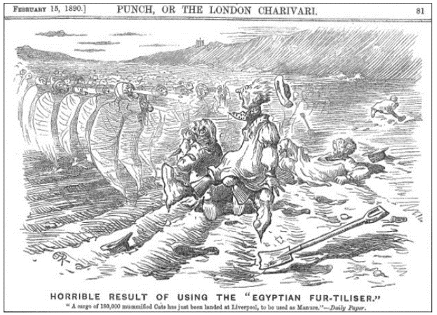Egyptians have always believed that animals were the manifestation of the divine on earth. Consequently, some animals, which reminded characters and powers of particular deities, became their sacred hypostasis. From the New Kingdom (ca. 1550-1069 BCE) to the Roman Period (ca. 30 BCE-395 CE), cats, dogs, hawks, ibises, crocodiles, snakes, fish, shrews, gazelles, and baboons were deliberately killed and mummified to be sold as votive offerings to worshippers. Through the mummification process these sacred avatars reached a semi-divine status, so their souls might move through the earthly and spiritual worlds, acting as messengers through whom believers might easily address their concerns to the gods. After being donated to the corrisponding gods at their temples, millions of votive animal mummies were buried in sacred necropoles throughout Egypt. As a result, they represent one of the largest categories of artifacts produced in Ancient Egypt.
Why
 In the 19th century, animal mummies emerged among the most popular souvenirs brought home by Victorian travelers. When the interest in these curios gradually decreased, animal mummies began to be used in papermaking, as wrappings supplied the high demand of rags used in newspaper production, and fertilizer industries, as the use of bone manure during the Victorian era was extremely common.
In the 19th century, animal mummies emerged among the most popular souvenirs brought home by Victorian travelers. When the interest in these curios gradually decreased, animal mummies began to be used in papermaking, as wrappings supplied the high demand of rags used in newspaper production, and fertilizer industries, as the use of bone manure during the Victorian era was extremely common.
The unconventional and unrecorded removal of these artefacts from their burial places caused an unavoidable loss of data, especially concerning the mummies’ date and provenience. The lack of contextual data, which constitutes the history of an object, was the main cause of a long-standing lack of interest in their study within the field of Egyptology. Although interest in these artefacts has grown considerably over the past thirty years, leading to numerous research projects focused on their study, challenges remain, particularly in determining their exact dates and places of production. This difficulty arises primarily from the absence of specialized diagnostic methods that could accurately identify their geographic origins. Additionally, commonly used techniques for dating these artefacts are problematic, as they tend to be invasive, costly and often unreliable. The only aspect on which who produced them left his signature are the wrapping patterns.
